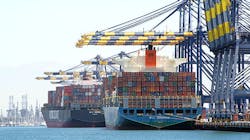From all indications, Sept. 1 is the start of the micro market season. When schools reopen, there will be a steady flow of employees streaming back to the workplace. That is what operators are hearing from facility managers around the country.
Micro market growth plans
Three of the operators featured in this edition of the Micro Market Design newsletter – Ryan Harrington of Royal Refresh and Frank Conley and Woody Kassin of Capital Provisions – have made it clear that they will be actively upgrading micro market locations, replacing manual foodservice venues with micro markets, and installing plenty of new locations in the coming months.
If you are among the many operators who expect plenty of micro market activity in the coming months, here is some useful advice:
Plan in advance – do not wait too long – start ordering now for September installations.
Supply chain is a mess
During the pandemic, the supply chain was damaged because of the virus itself, impacting manufacturing and shipping. Now, micro markets are red hot, and everybody seems to want one. That is great news for operators, until they must delay an installation because the equipment is not available.
“Currently, you have two problems: high demand and a broken supply chain,” said Greg Portell, a partner in the consulting firm Kearney in an interview with the Washington Post. “All of the places where this stuff gets manufactured, whether internationally or domestically, have been disrupted by COVID-19 and are under enormous strain.”
Start planning for Sept. 1 installations
Operators need to be ready and you can’t wait until July to start planning,” urged Troy Geis-Hernandez, cofounder and CEO of Fixturelite, the leading supplier of micro market retail displays, equipment and design tools and support. “They need to be ready now, creating designs, getting customer sign offs and getting deals closed, because the supply chain will be straining from the demand for micro market fixtures, coolers and accessories.”
“Compared to the past, supply is extremely tight. The turnaround time is slower than we have seen it in a long time. There is a shortage of lumber and labor, along with shipping disruptions like the one we saw in the Suez Canal. This creates a ripple effect, only aggravating the situation. We are still dealing with issues from the Texas weather and power grid incident. According to the Wall Street Journal and in our experience as well, that incident alone is resulting in material shortages and delays ultimately felt by consumers” he added.
According to the Los Angeles Times, the demand for inbound products is clogging the nation’s biggest ports, from Savannah, GA, on the East Coast to Los Angeles. “I flew over the coast of Los Angeles a couple of weeks ago and counted 38 container ships sitting idle.” said Steve Orlando, cofounder of Fixturelite. The number of container ships waiting to enter the neighboring ports of Los Angeles and Long Beach stood at nearly 30 late Thursday, with an average wait of more than a week. Parked in San Francisco Bay were about a dozen container vessels waiting to berth at the Port of Oakland, according to satellite tracking.
A silver lining
Orlando went on to say that there is a silver lining associated with the supply chain mess. “Every operator has been saying that the selling cycle has been painfully longer during the pandemic. Since everyone has heard about the supply chain challenges, this situation presents an opportunity for an operator to have a serious conversation with a prospect,” he said.
“The prospective client needs to face the reality that the deal needs to get done and the equipment needs to be ordered if they want to have a micro market in place when their office repopulates,” said Orlando. “HR managers are hungry to have amenities in place for the return of the workforce. Leverage that desire and speed up the sales cycle.”
Plan and act now
“There is going to be a surge in demand for equipment in the near future,” explained Geis-Hernandez. “We have a lot of pull as a major supplier in the micro market industry, but there is only so much we can do. What operators need to do is order early and build a stockpile of equipment.”
“Any operator who is sitting on inventory of micro market fixtures, coolers and accessories, will enjoy a huge competitive advantage this fall,” Orlando added. “Now is the time to plan and take action.”
Order now for a competitive advantage: www.fixturelite.com
